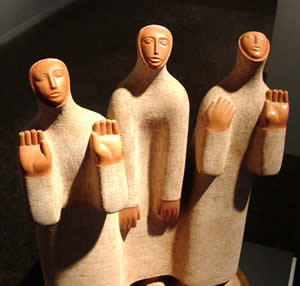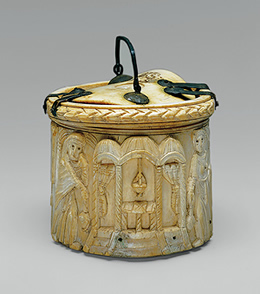"They Have Taken Away My Lord
and I Do Not Know Where They Have Laid Him"
A guest essay by Kathryn Greene-McCreight (PhD Yale). Kathryn is an Episcopal priest in New Haven, CT, and author of the book Darkness is My Only Companion; A Christian Response to Mental Illness (2006) and Feminist Reconstructions of Christian Doctrine: Narrative Analysis and Appraisal (2000).
For Sunday April 4, 2010
Easter 2010
Lectionary Readings (Revised Common Lectionary, Year C)
Acts 10:34–43 or Isaiah 65:17–25
Psalm 118:1–2, 14–24
1 Corinthians 15:19–26 or Acts 10:34–43
John 20:1–18 or Luke 24:1–12
Back in ancient times when I was a seminarian, my New Testament Interpretation professor, who was a thorough-going historical critic, had become suspicious that the younger generation of his guild was engaged in a “New Thing.” Isaiah 65 proclaims that God is doing a “new thing” with and for Israel: a promise of hope. But my professor feared that the New Testament Guild’s “New Thing” bore precious little hope, and bore very little relationship with the Old, Old Story of Jesus and his Love.
I will never forget his lecture Easter Monday, which coincided with his treatment of the newer methods and their results. He whispered to us, and that man could whisper with such force that all 150 of us in the auditorium could hear him clearly. In the words of the weeping Mary Magdalene (Jn 20:13) he made a blunt assessment: They have taken away my Lord and I do not know where they have laid him. (Jn 20:13)
 |
Peter Lupori, Women at the Tomb. |
Why does Mary say this, especially on that First Easter morning? Isn’t she supposed to be full of hope? She notices that the stone has been rolled away from the tomb, and yet she weeps? Mary Magdalene was expecting Jesus’ body to be in that tomb. They have taken away my Lord and I do not know where they have laid him.
We think of Easter as a joyful time as we read of the women finding the tomb empty. All of the men and women who had known and loved and followed and learned from Jesus should be, so we think, joyful on that Day of Resurrection. After all, Jesus had told them at least three times during his earthly ministry (e.g. cf. Mark 8:31-33; 9:30-32; 10:33-34) that He would be killed by the religious and secular rulers in Jerusalem. Why didn’t his followers get this? Why does Mary bottom out with sorrow when she finds the tomb empty? They have taken away my Lord, and I do know where they have laid him.
 |
Pyxis Depicting Women at the Tomb of Christ,
500s, Byzantine. |
Since Mary had fully expected to find the Lord’s dead body in the tomb, she was devastated to find the tomb empty instead. She was not expecting the Resurrection of the Lord Jesus. It had not occurred to her that Jesus would have risen from the dead, despite his sayings during his earthly life about his impending murder and subsequent resurrection.
And so, those who are among what Schleiermacher called "the cultured despisers of Christianity" stop there, at the empty tomb. For these "Despisers," the empty tomb proves nothing, declares nothing, promises nothing. And the conclusion of these "Despisers" is that Jesus’ life was simply poor, solitary, nasty, brutish, and short (Hobbes). In their view, Jesus' Messiahship was a failure. His teachings were void of any truth. His death was just like all others: Vanity of vanities, and striving after wind (Ecclesiastes 1:2, 14).
They have taken away my Lord and I do not know where they have laid him. Mary thinks that something precious has been lost to her, namely her Lord’s life and presence. Notice, though, that she runs to the tomb before Easter Sunday actually begins. As Gentiles, most of us may be a bit confused here. The description in the text goes thus: Early on the first day of the week, while it was still dark... For Jews, (and, of course, Jesus and all of his first followers were Jewish) the day is reckoned from evening to morning, and not from morning to evening as in the Gentile world. So Genesis describes the days of creation in this way: and there was evening, and there was morning, the first day. And thus it is from Genesis 1:5 and throughout the rest of the chapter. Since it was still dark when Mary rushed to the tomb, it was not yet morning, not yet Sunday, not yet the first day of the week, not yet the Day of Resurrection.
 |
By He Qi. |
We must remember how significant is the contrast between darkness and light in the Scriptures. We notice this right from the beginning pages of both the Old Testament and the New as well. The first act of creation on the first day is light itself: And God said “Let there be Light,” and behold, there was Light. (Gen 1:3) This light conquers the dark in John 1:5: The light shines in the darkness, and the darkness did not overcome it (or, in the KJV, comprehendeth it not.)
So Mary Magdalene shows up at the empty tomb in the dark of the Sabbath, before the first rays of dawn on the Day of Resurrection. And at finding the stone rolled away from the tomb, and Jesus’ body missing, her natural reaction is to weep in that dark before the dawn. For as yet they did not understand the Scripture, that Jesus must rise from the dead (Jn 20:9).
Mary’s statement, They have taken away my Lord and I do not know where they have laid him, is for her one of horror, loss, confusion. But Count it all joy, brothers and sisters. For Mary, and for Peter and John, and for the rest of the disciples, and for later Christians including us, the Empty Tomb is the cause of our great rejoicing. Because the body of the Lord has not been stolen (cf. Mt 27:64; 28:13-15). They have not taken away our Lord. He is present with us, Emmanuel, and behold, He is even present with us to the end of the ages (Mt 1:23; 28:20).
What do our gospel texts tell us happened to the body? Nothing. The canonical Gospels explain nothing: not biologically, not visually, not audibly. The non-canonical Gospel of Peter portrays a huge, bouncing, speaking cross emerging from the tomb. But our canonical gospels are more to the point: this Resurrection is not to be explained scientifically or chemically. Jesus’ body has of its own simply vanished.
 |
Women at the tomb. |
Only later does Jesus appear, and only later does he express his affection and tenderness and hunger and even, yes, he permits Thomas to probe his wounds. The Resurrected Jesus is not a ghost. He remains a man, and yet Son of God. Recognizable, even, to his friends, but not immediately so. The wounds of his murder, by which we ourselves are healed, remain in and on his body even after his resurrection. He is the same, but different.
Jesus’ resurrection says more than that a dead man lives again. Yes, Jesus’ resurrection is categorically different from his raising of Lazarus, who was destined to die even after Jesus’ great sign in raising him up from death. Resurrection is more than dead men walking: it points to the inbreaking of God’s rule over all that alienates itself from him. And so all of us who are baptized into Christ Jesus, and thus into his death, know that we will share in his resurrection. Just as Christ was raised from the dead by the glory of the Father, so we too might walk in newness of life (Rom 6:4) And so, the Resurrected Jesus responds to our doubts about his presence among us every day of our lives with this question: Why do you seek the living among the dead? He is not here, but has risen? (Lk 24:5).
For further reflection:
* Consider Paul's words that with his resurrection Jesus "destroyed death" (2 Timothy 1:10), our "last enemy" (1 Corinthians 15:26).
Image credits: (1) The College of Saint Catherine; (2) MetMuseum.org; (3) www.Catholica.com; and (4) VisibleKingdom.com.





